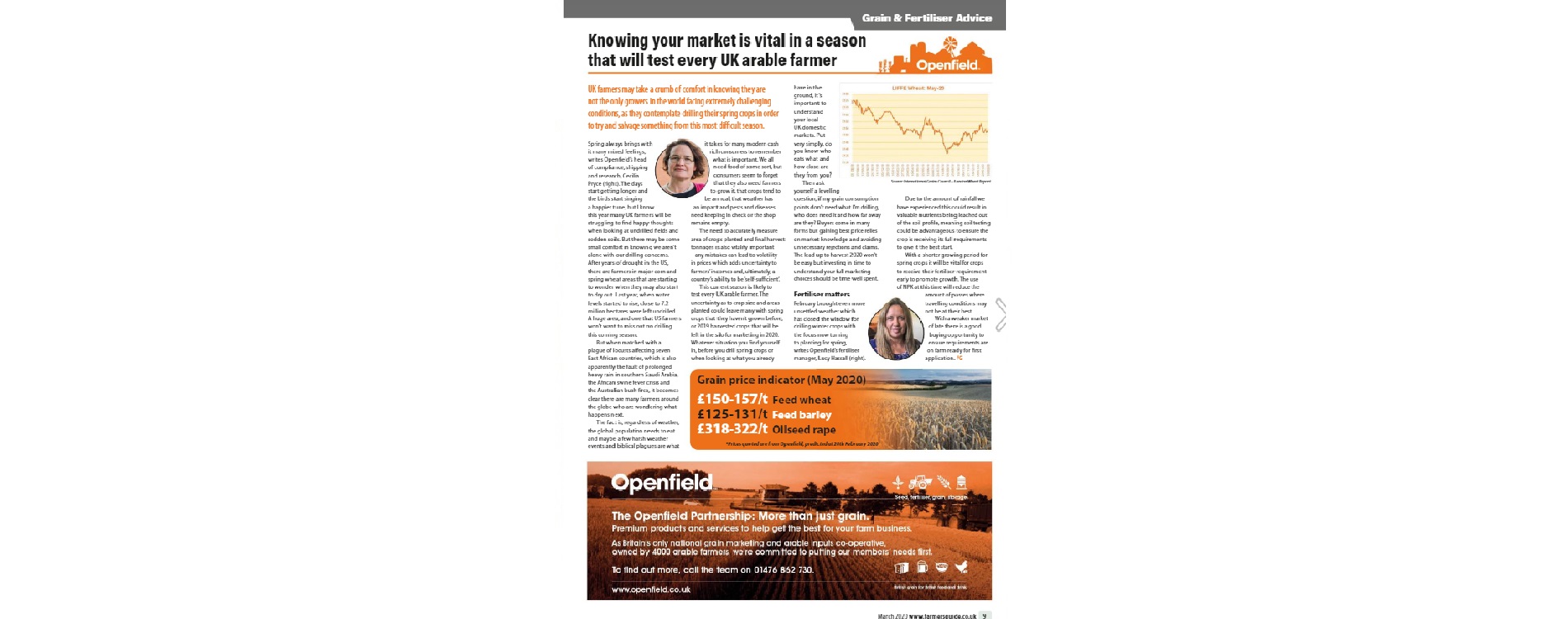Knowing your market is vital in a season that will test every UK arable farmer
Openfield’s Grain & Fertiliser update, featured in March’s Farmers Guide Magazine.
Grain
UK farmers may take a crumb of comfort in knowing they are not the only growers in the world facing extremely challenging conditions, as they contemplate drilling their spring crops in order to try and salvage something from this most difficult season.
Spring always brings with it many mixed feelings, writes Openfield’s head of compliance, shipping and research, Cecilia Pryce (right). The days start getting longer and the birds start singing a happier tune, but I know this year many UK farmers will be struggling to find happy thoughts when looking at undrilled fields and sodden soils. But there may be some small comfort in knowing we aren’t alone with our drilling concerns.
After years of drought in the US, there are farmers in major corn and spring wheat areas that are starting to wonder when they may also start to dry out. Last year, when water levels started to rise, close to 7.2 million hectares were left undrilled. A huge area, and one that US farmers won’t want to miss out on drilling this coming season. But when matched with a plague of locusts affecting seven East African countries, which is also apparently the fault of prolonged heavy rain in southern Saudi Arabia, the African swine fever crisis and the Australian bush fires, it becomes clear there are many farmers around the globe who are wondering what happens next.
The fact is, regardless of weather, the global population needs to eat and maybe a few harsh weather events and biblical plagues are what it takes for many modern cash rich consumers to remember what is important. We all need food of some sort, but consumers seem to forget that they also need farmers to grow it, that crops tend to be annual, that weather has an impact and pests and diseases need keeping in check or the shop remains empty.
The need to accurately measure area of crops planted and final harvest tonnages is also vitality important – any mistakes can lead to volatility in prices which adds uncertainty to farmers’ incomes and, ultimately, a country’s ability to be ‘self-sufficient’. This current season is likely to test every UK arable farmer. The uncertainty as to crop size and areas planted could leave many with spring crops that they haven’t grown before, or 2019 harvested crops that will be left in the silo for marketing in 2020.
Whatever situation you find yourself in, before you drill spring crops or when looking at what you already have in the ground, it’s important to understand your local UK domestic markets. Put very simply, do you know who eats what and how close are they from you? Then ask yourself a levelling question; if my grain consumption points don’t need what I’m drilling, who does need it and how far away are they? Buyers come in many forms but gaining best price relies on market knowledge and avoiding unnecessary rejections and claims.
The lead up to harvest 2020 won’t be easy but investing in time to understand your full marketing choices should be time well spent.
Fertiliser matters
February brought even more unsettled weather which has closed the window for drilling winter crops with the focus now turning to planting for spring, writes Openfield’s fertiliser manager, Lucy Hassall. Due to the amount of rainfall we have experienced this could result in valuable nutrients being leached out of the soil profile, meaning soil testing could be advantageous to ensure thecrop is receiving its full requirements to give it the best start.
With a shorter growing period for spring crops it will be vital for crops to receive their fertiliser requirement early to promote growth. The use of NPK at this time will reduce the amount of passes where travelling conditions may not be at their best. With a weaker market of late there is a good buying opportunity to ensure requirements are on farm ready for first application.




